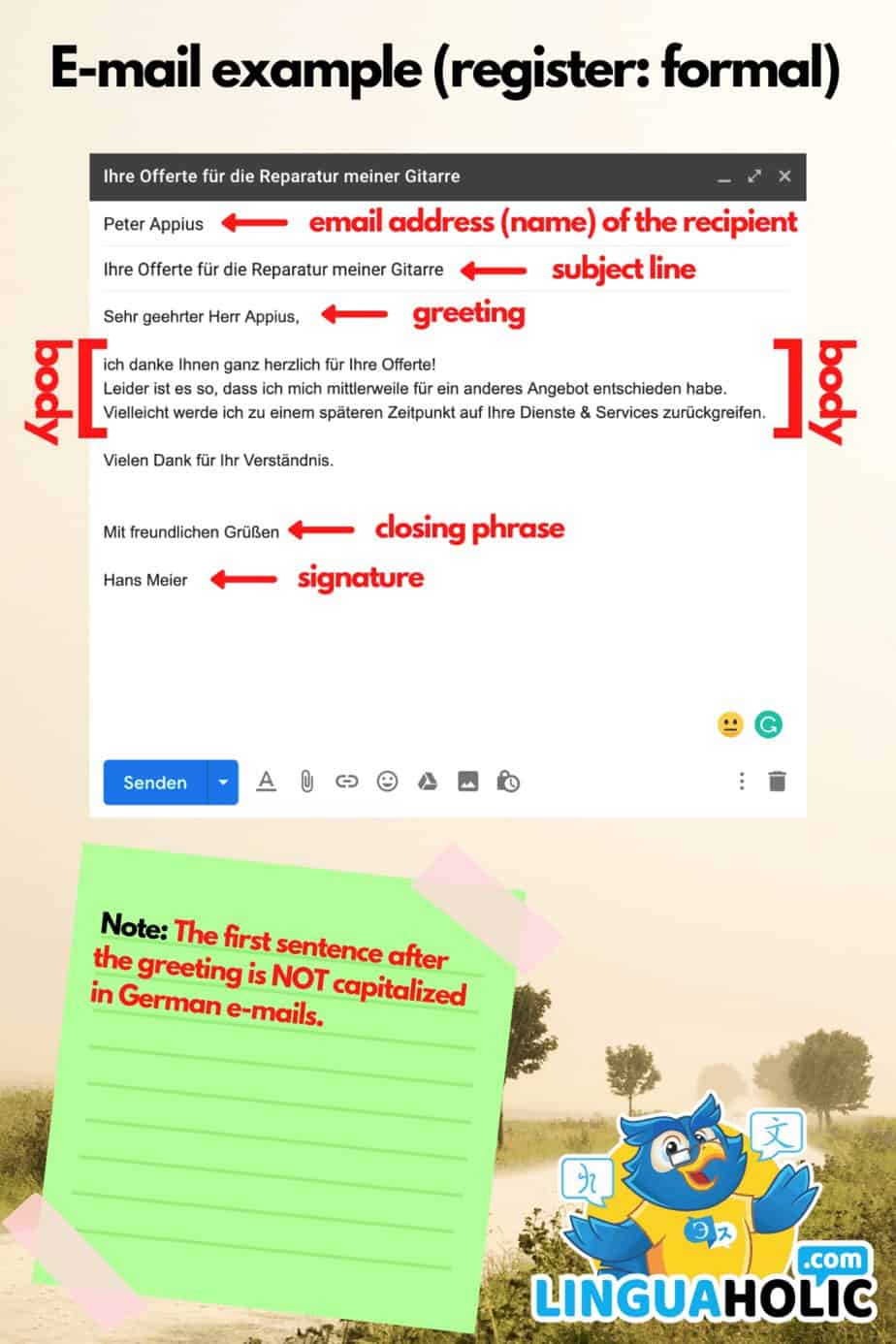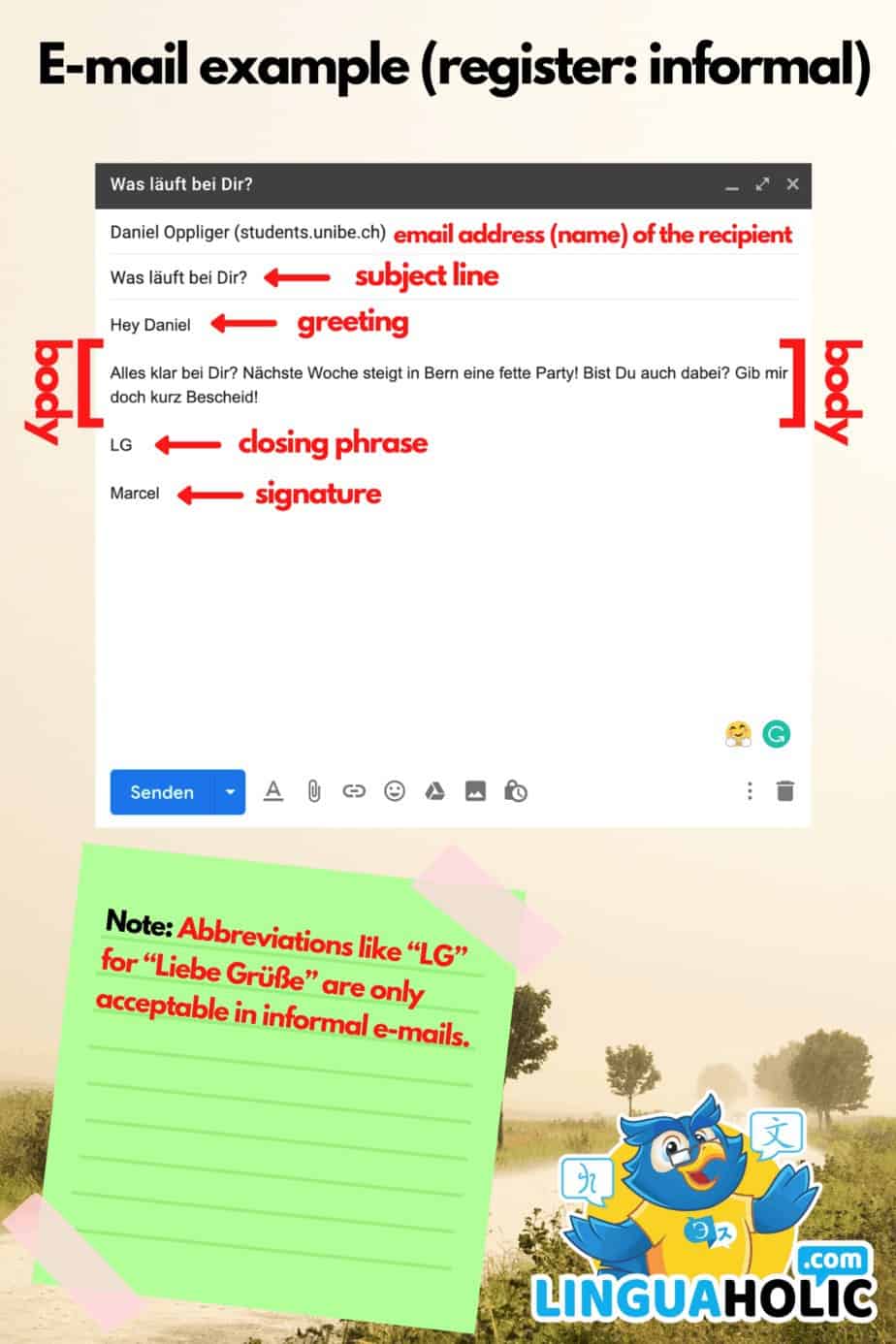Writing e-mails in a foreign language is not always easy. Sometimes this is due to a lack of knowledge of the technical vocabulary, but sometimes the problems are simply related to a lack of knowledge of the foreign culture.
How formal should an e-mail in German be? When should you use “Sie” and when can you switch to “Du”?
When writing e-mails in German, there are some stumbling blocks to overcome. That’s for sure.
But don’t worry. We will now go into great detail about these very problems!
[toc]

How to address people in German e-mails: Greetings
The choice of greeting depends on various factors.
An e-mail is either written in formal or informal language, depending on how well you know the recipient and what your relationship with the recipient is.
When writing to friends & family, you would usually choose an informal register.
When writing to your boss, colleagues & people that you don’t actually know (in person), you would usually stick to formal language.
In case of doubt, it is usually better to stick with formal language rather than risking being rude by choosing a register that is deemed too informal.
Let us now introduce the most common greetings, both informal & formal variants.
And please note that after each and every greeting, there is a mandatory comma (not in Switzerland, though).
Informal
Hallo Marcel, – Hi Marcel
Hallo Petra, – Hi Petra
Hey Peter, – Hey Peter
Formal
Sehr geehrte Frau Müller, / Sehr geehrter Herr Müller, – Dear Ms. Müller / Dear Mr. Müller
Sehr geehrte Kundin, / Sehr geehrter Kunde, – Dear customer / Dear client
Guten Tag Frau Müller, / Guten Tag Herr Müller, – Good afternoon Ms. Müller / Good afternoon Mr. Müller
Liebe Frau Müller, / Lieber Herr Müller, / – Dear Ms. Müller / Dear Mr. Müller
Hallo, Herr Baumann, – Hi, Mr. Baumann
Note: (This last greeting [Hallo, Herr/Frau XYZ] is certainly a little bit less formal than “Sehr geehrte(r) or even Liebe(r).”
However, in German, it is still an acceptable and formal way to address someone, even if we are talking about businessmen that are using the formal form of address “Sie” when communicating with each other.
If the recipient of the e-mail is unknown
If the recipient of the e-mail is unknown, you would, in most cases, choose a formal salutation.
In German, the most common salutation for that purpose is “Sehr geehrte Damen und Herren.” You can use it for both e-mails and also printed letters whenever the recipient of the e-mail is unknown.
Sehr geehrte Damen und Herren ― Dear Sir or Madam / Dear Ladies and Gentleman
If you are dealing with a bigger target audience, in German, you would still stick to “Sehr geehrte Damen und Herren” even in cases where in English you would choose something along the lines of “To whom it may concern”.
If there is more than one recipient
In some cases, you might want to write one single e-mail but still talk to more than just one person. So how would you go about addressing the recipients in this case?
Let’s say you are writing an e-mail to Ms. Meier, but you would also greet Mr. Meier at the same time.
Here’s how you would need to do that:
Sehr geehrte Frau Meier, sehr geehrter Herr Meier,
How to address people in German e-mails: “Sie” vs. “Du”
Whenever you are going to write an e-mail, you will have to choose between the polite “Du” and the familiar “Sie” when addressing the recipient of the message.
As a native speaker of English, this might be a little bit confusing, as there is no such thing in English.
But don’t worry, please. It is actually not that that difficult.
Generally speaking, if you are writing an e-mail to someone that you know very well (family, friends), you will always address this person with “Du.”
However, if you are talking to your boss, for instance, you might need to address him or her with “Sie.” The same is true with other people in official/business settings, especially with people that you are not (very) familiar with.
If you are sending an e-mail to someone that you have never ever seen/met, you would usually use “Sie” instead of “Du” unless you are certain that you are talking to a child (teenager), then you would use “Du” instead.
Changing from “Sie” to “Du”
During e-mail exchanges, it is also possible that the recipient of the message will take the initiative to use “Du” instead of “Ihr.
Sometimes that happens after a few e-mails have been exchanged.
If that is the case, and both the sender and the recipient are adults, then it is totally fine to switch to “Du” as well.
Usually, it is the older person that offers this to the younger person. Not always, though, as with e-mails, the age of the recipient of the message is often not known.
Moreover, if you are in contact with let’s say the customer care department of some companies, they might address you with “Du” from the get-go or a couple of e-mail messages, and if that happens, you can obviously switch to “Du” as well.
“Sie” to “Du”: A matter of respect that holds some weight
The distinction of “Du” and “Ihr” is definitely something that holds a certain weight in the German language and should not be taken (too) lightly.
In cases of doubt, you should always go for “Sie” rather than “Du.” Like this, you won’t come across as rude and you’ll give the recipient of the message the chance to introduce the “Du” to you (later on).
Examples of possible sentences in e-mails using “Du”
Examples:
Ich wollte Dich fragen, ob du nächste Woche schon etwas vorhast. / I was wondering if you have any plans for next week
Hast Du vielleicht Lust, nächste Woche mit mir ins Kino zu gehen? / Would you like to go to the cinema (with me) next week?
Hast du deinen Job nun bei Google schon aufgegeben oder arbeitest du immer noch dort? / Did you stop working for Google or do you still work there?
Examples of possible sentences in e-mails using “Sie” & “Ihre”
Examples:
Ich möchte Sie darauf hinweisen, dass wir die Rechnung bereits letzte Woche bezahlt haben. / I would like to point out that we already paid the bill last week.
Sie können doch meine Nachrichten nicht einfach so ignorieren. / I am sorry, but how could you just ignore my messages like that
Ich möchte Sie nun ganz herzlich darum bitten, mir doch eine Offerte zukommen zu lassen. / I would kindly like to ask you to send me an offer.
Ihre Firma gefällt mir sehr gut. Ich hoffe, dass wir in Zukunft zusammenarbeiten können. / I like your company very much. I hope that we can work together in the future.
German E-mail Openers
After the e-mail subject line and the general salutation, the first sentence of your e-mail all depends on the actual nature of the e-mail.
If you are replying to an e-mail, the first sentence of your digital message will usually serve to present your thanks. Here are some possible openers for you:
- Vielen Dank für Ihre Mail. / Thanks a lot for your e-mail.
- Vielen Dank für Ihre Nachricht. / Thanks a lot for your message.
- Vielen Dank für die Kontaktaufnahme. / Thanks for getting in touch.
- Ich habe Ihre Nachricht soeben erhalten. Vielen Dank dafür. / I have just received your message (e-mail). Thank you.
If your e-mail is not a reply to a previous e-mail, you would usually state the purpose of your e-mail in the very first sentence after the greeting.
Please note that in German, the first sentence after the greeting is NOT capitalized.
Example:
Sehr geehrte Frau Ammann,
ich möchte Ihnen hiermit mitteilen, dass ich das Paket heute erhalten habe. Leider ist die Lieferung allerdings nicht komplett, denn es wurden nur drei anstatt 4 Kugelschreiber geliefert.
Example Translation:
Dear Ms. Ammann
I have received the package today. Unfortunately, the delivery is not complete, because only three instead of 4 pens were delivered.
German E-mail Sign-off: Closing phrases
After the text body, you will want to make sure to use an appropriate closing phrase to close your letter accordingly. Here are a couple of possible closing phrases.
Mit freundlichen Grüßen / Yours sincerely
Freundliche Grüße / With kind regards, (kind regards)
Bis bald / See you soon (note: you would only use that if you are planning to see the other person in person soon)
Beste Grüße / Best regards (rather informal)
(Viele) Liebe Grüße / Best regards
Wir hören uns bald / I will talk to you soon! (informal)
This phrase is almost always appropriate and in case of doubt, it is best to just use that phrase instead of trying to come up with something more creative.
German E-mail Sign-off: Name (& Signature)
After having chosen one of the closing formulas from above, all that is left to do for you is to provide your typed name.
The complexity of this very last step in your German e-mail depends on the nature of the e-mail.
How to sign off informal letters in German
If you are writing an e-mail to your friends or family, all you need to provide is your first name in typed form.
So, to close off an e-mail you would simply write something like:
Liebe Grüße,
Peter
If you would like to have it more informal, you can also make use the abbreviation of “Liebe Grüße” which is just simply “LG”, which would then give us the following:
LG
Peter
How to sign off formal letters in German
In formal e-mails, you would provide your full name rather than just your first name.
This is usually the case if you are writing an e-mail to work colleagues (that you are not very familiar with or not familiar at all) or to strangers or company staff that you don’t have aIt would then look like this:
Mit freundlichen Grüßen,
Peter Hart
Sign-offs in German business correspondence
Generally speaking, as just discussed, signatures in e-mails are almost similar to signatures in written letters, just without the hand-signed signature obviously.
In German business correspondence, however, you would also need to make sure that certain additional information is given at the end of the e-mail. (e. g. name of the company, job title, etc.)
More often than not, in business e-mails, this kind of information is automatically included (has hopefully been configured by your company).
At least if you are writing from your office computer using software such as Microsoft Outlook, chances are that your e-mails have already been configured in a way that this information is pulled automatically.
If it is not included, you might need to add it by yourself.
If your e-mails are required to meet higher legal standards, you might also need to include a digital signature.
Common abbreviations in e-mails
There are a couple of abbreviations that are commonly used in e-mail communication.
One abbreviation that you stumble upon all the time, is “MfG,” which simply stands for “Mit freundlichen Grüßen.” As we have seen earlier in this article, “Mit freundlichen Grüßen” is one of the most common ways to close E-mails in German.
In fact, “Mit freundlichen Grüßen” is also very common in conventional letter writing.
However, it needs to be said that abbreviations of greetings is not deemed good style in formal e-mail writing.
So whenever you are writing to your boss or maybe just reaching out to Amazon Germany to inquire about your latest purchase, you should avoid using abbreviations such as “MfG” and similar expressions, as using abbreviated greetings is not acceptable in formal e-mails, especially not in business correspondence.
Other common abbreviations that may or may not be used in E-mails depending on the situation include:
[table id=17 responsive=”scroll” /]
Things to avoid when writing e-mails in German
In formal e-mail writing, it is an absolute no-go to write everything in small letters. Even in informal letters, this might come across as you being disinterested in communicating and being careless.
Also, the punctuation should be on point (no pun intended). Question marks, full stops and even commas should be retained in both formal and informal writing.
Use e-mails for these kinds of messages
Messages & letters by e-mail are just as widespread in German-speaking countries as in English-speaking countries.
What’s the point?
The point is that using e-mail as a means of communication is totally fine for a wide variety of messages & different types of letters.
The following is a list of various letters that can easily be written as e-mail without coming across as unprofessional.
- apology letters
- letters of application
- order confirmation letters
- letters of complaint
- inquiry letters
- sales letters
- follow-up letters
- cover letters
- thank you letters
However, there are also a couple of letters that are not suitable to be written in e-mail form at all.
The following letters, as exemplified in the next section, need to be sent as real letters (mail) and some of them even need to be written by hand.
E-mail is not always the appropriate medium
As in English, E-mail is not always the appropriate communication channel.
However, if you are writing a letter of condolence for instance, as the name actually already indicates, you should indeed write it by hand instead of simply crafting an E-mail. This holds true for both English and German.
Another example would be the greeting card whenever a baby is born. In both Germany and Switzerland, a physical card needs to be written for that purpose. You just wouldn’t communicate that kind of thing with an E-mail. At least not yet.
If you, as a company, are writing recovery wishes to your staff, these kinds of letters should also be written by hand rather than communicated by e-mail.
Also, the termination of an employment contract may not be sent as an e-mail at all, as this is against the law.
5 tips to write great e-mails in German
- Keep it short and concise
- Don’t use abbreviations for greetings when writing German business correspondence e-mails
- Use “Sie” rather than “Du” to address people when in doubt about the correct form
- Craft a meaningful subject line
- Avoid careless mistakes (slips of the pen), as this might come across as very unprofessional
German E-mail examples
Sample Email | German | Formal
Sample Email | German | Informal
Writing E-Mails in German: Wrapping it all up
There you go. You should now have all the necessary tools in your toolshed to write perfect E-mails in German. And even if they are not immaculate yet, practice makes perfect, right?
Writing E-mails in German: FAQ
Is “Sehr verehrte(r) Herr/Frau XYZ” a valid form of salutation?
Only Use “Sehr verehrte(r) Herr/Frau XYZ” if you know the recipient of the e-mail in person. However, it is usually better to just use “Sehr geehrter” instead of “Sehr verehrter” as the latter greeting extremely respectful way to address someone and is often not necessary, even a bit awkward.
May I use “Hallo” in German e-mail (business) correspondence?
Yes. It is possible to use “Hallo” even in rather formal e-mails. However, in some cases, it might come across as a little bit rude, so if you want to be absolutely sure that your salutation will be acknowledged as formal enough, use “Sehr geehrte(r) Frau/Herr” rather than “Hallo.”
How to sign off e-mails in German?
To close e-mails in German, you will need a closing phrase followed by your typed name. In German business correspondence, “Mit freundlichen Grüßen,” + [Full Name] is usually a good way to go about it. If you are writing to a friend, you can simply sign off the e-mail by writing something along the lines of “Liebe Grüße,” + [Surname] or even “Bis bald,” + [Surname] if you are planning to meet up with your friend anytime soon. Please note that the closing phrase (+ comma) and the name that follows are actually written on separate lines, just as in English.
When should I use “Hochachtungsvoll” in e-mails?
“Hochachtungsvoll” is considered extremely polite language and is also pretty archaic. In most cases, you wouldn’t use “hochachtungsvoll” in e-mails. In English, “hochachtungsvoll” corresponds to ‘Respectfully yours’ or ‘Very truly yours.’
What are some alternatives to “Mit freundlichen Grüßen”?
Instead of the formal “Mit freundlichen Grüßen”, you could use “Freundliche Grüße” or “mit freundlichem Gruß.” Both of these express a very similar level of formality.

Hey fellow Linguaholics! It’s me, Marcel. I am the proud owner of linguaholic.com. Languages have always been my passion and I have studied Linguistics, Computational Linguistics and Sinology at the University of Zurich. It is my utmost pleasure to share with all of you guys what I know about languages and linguistics in general.



